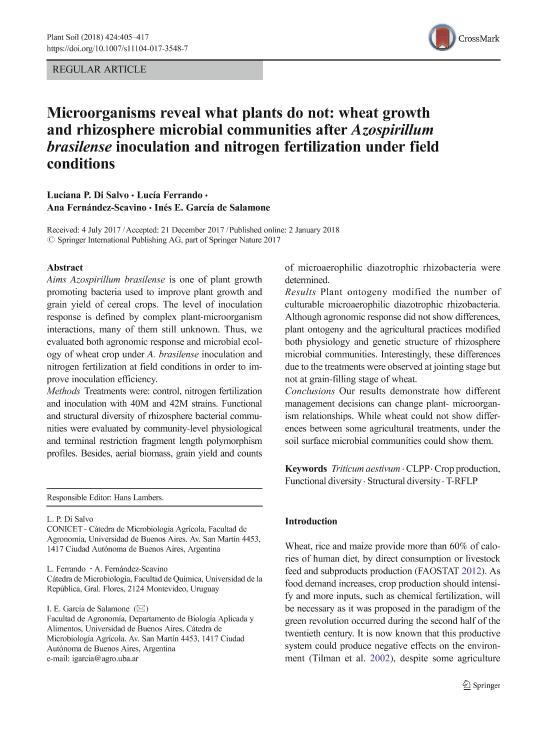Mostrar el registro sencillo del ítem
dc.contributor.author
Di Salvo, Luciana Paula

dc.contributor.author
Ferrando, Lucía
dc.contributor.author
Fernández Scavino, Ana
dc.contributor.author
Garcia, Inés Eugenia

dc.date.available
2020-01-29T20:40:05Z
dc.date.issued
2018-03
dc.identifier.citation
Di Salvo, Luciana Paula; Ferrando, Lucía; Fernández Scavino, Ana; Garcia, Inés Eugenia; Microorganisms reveal what plants do not: wheat growth and rhizosphere microbial communities after Azospirillum brasilense inoculation and nitrogen fertilization under field conditions; Springer; Plant and Soil; 424; 1-2; 3-2018; 405-417
dc.identifier.issn
0032-079X
dc.identifier.uri
http://hdl.handle.net/11336/96163
dc.description.abstract
Aims: Azospirillum brasilense is one of plant growth promoting bacteria used to improve plant growth and grain yield of cereal crops. The level of inoculation response is defined by complex plant-microorganism interactions, many of them still unknown. Thus, we evaluated both agronomic response and microbial ecology of wheat crop under A. brasilense inoculation and nitrogen fertilization at field conditions in order to improve inoculation efficiency. Methods: Treatments were: control, nitrogen fertilization and inoculation with 40M and 42M strains. Functional and structural diversity of rhizosphere bacterial communities were evaluated by community-level physiological and terminal restriction fragment length polymorphism profiles. Besides, aerial biomass, grain yield and counts of microaerophilic diazotrophic rhizobacteria were determined. Results: Plant ontogeny modified the number of culturable microaerophilic diazotrophic rhizobacteria. Although agronomic response did not show differences, plant ontogeny and the agricultural practices modified both physiology and genetic structure of rhizosphere microbial communities. Interestingly, these differences due to the treatments were observed at jointing stage but not at grain-filling stage of wheat. Conclusions: Our results demonstrate how different management decisions can change plant- microorganism relationships. While wheat could not show differences between some agricultural treatments, under the soil surface microbial communities could show them.
dc.format
application/pdf
dc.language.iso
eng
dc.publisher
Springer

dc.rights
info:eu-repo/semantics/openAccess
dc.rights.uri
https://creativecommons.org/licenses/by-nc-sa/2.5/ar/
dc.subject
CLPP
dc.subject
CROP PRODUCTION, FUNCTIONAL DIVERSITY
dc.subject
STRUCTURAL DIVERSITY
dc.subject
T-RFLP
dc.subject
TRITICUM AESTIVUM
dc.subject.classification
Agricultura

dc.subject.classification
Agricultura, Silvicultura y Pesca

dc.subject.classification
CIENCIAS AGRÍCOLAS

dc.title
Microorganisms reveal what plants do not: wheat growth and rhizosphere microbial communities after Azospirillum brasilense inoculation and nitrogen fertilization under field conditions
dc.type
info:eu-repo/semantics/article
dc.type
info:ar-repo/semantics/artículo
dc.type
info:eu-repo/semantics/publishedVersion
dc.date.updated
2020-01-29T19:10:46Z
dc.journal.volume
424
dc.journal.number
1-2
dc.journal.pagination
405-417
dc.journal.pais
Alemania

dc.description.fil
Fil: Di Salvo, Luciana Paula. Universidad de Buenos Aires. Facultad de Agronomía; Argentina. Consejo Nacional de Investigaciones Científicas y Técnicas; Argentina
dc.description.fil
Fil: Ferrando, Lucía. Universidad de la República; Uruguay
dc.description.fil
Fil: Fernández Scavino, Ana. Universidad de la República; Uruguay
dc.description.fil
Fil: Garcia, Inés Eugenia. Consejo Nacional de Investigaciones Científicas y Técnicas; Argentina. Universidad de Buenos Aires. Facultad de Agronomía; Argentina
dc.journal.title
Plant and Soil

dc.relation.alternativeid
info:eu-repo/semantics/altIdentifier/url/http://link.springer.com/10.1007/s11104-017-3548-7
dc.relation.alternativeid
info:eu-repo/semantics/altIdentifier/doi/http://dx.doi.org/10.1007/s11104-017-3548-7
Archivos asociados
